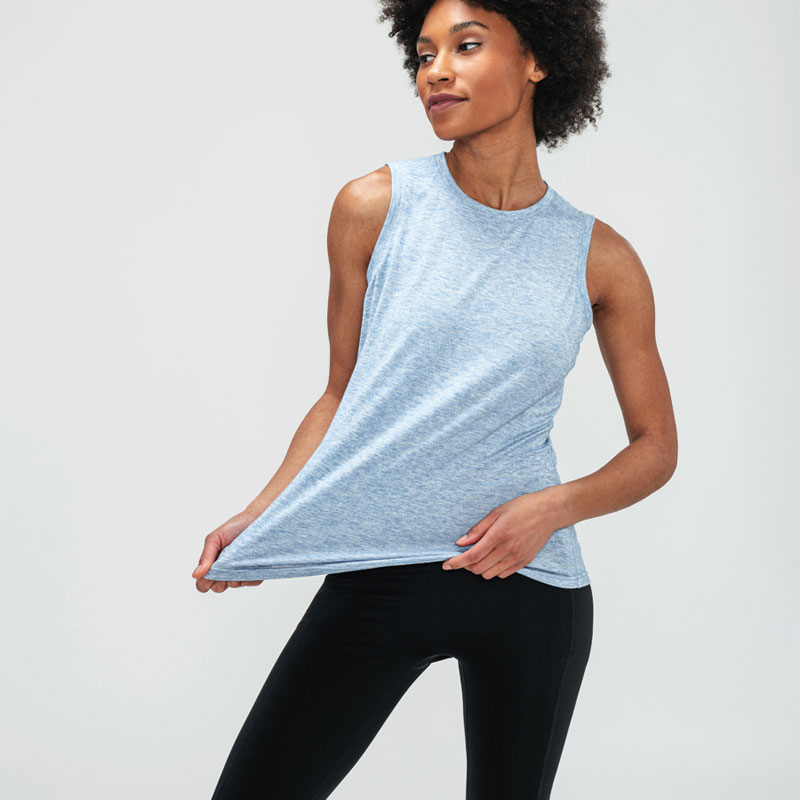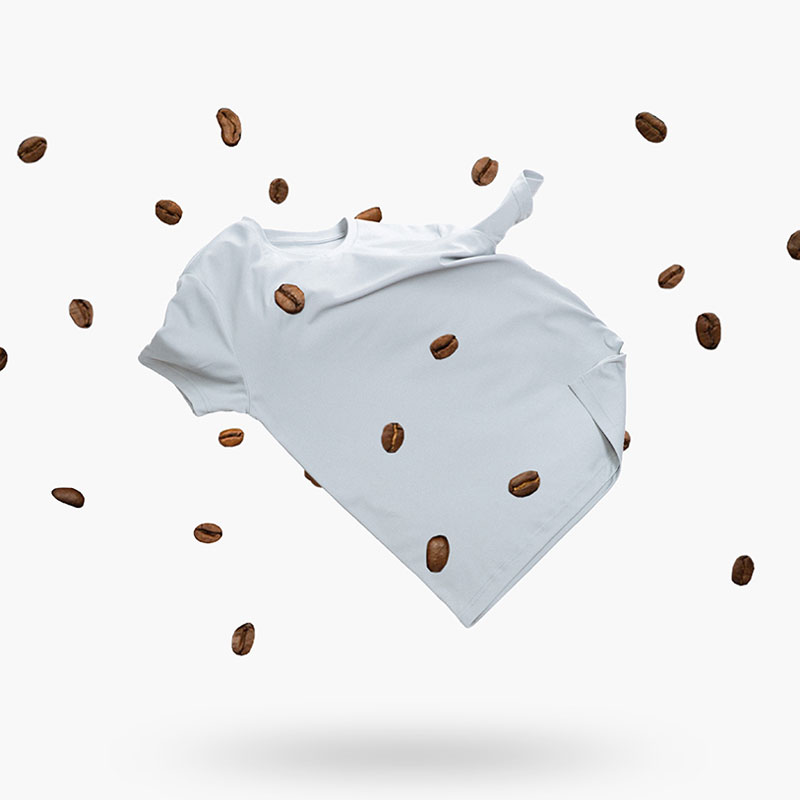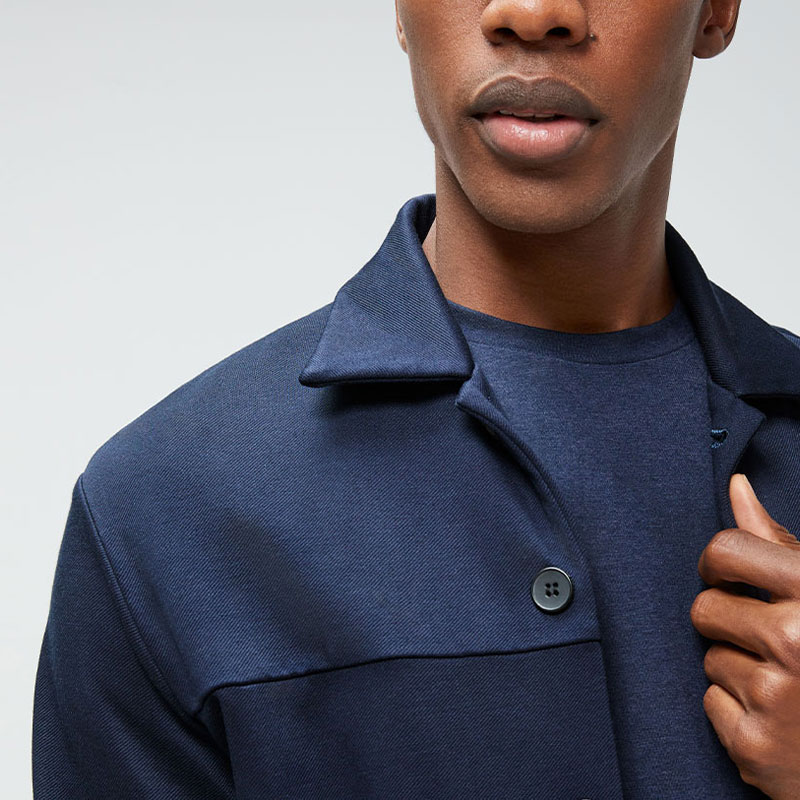What are bio-based materials?
A bio-based material is made from substances derived from living organisms such as plants, trees or animal products. We use several types of bio-based materials when creating our garments, including Merino wool and coffee beans, as well as new semi-natural/ semi-synthetic versions of materials like viscose and polyester. Learn more below.
Merino Wool
Our Composite fabric features 45% recycled polyester blended with Merino wool – it’s the evolution of our next-to-skin fabrics.


3 Features of Next-to-Skin Wearability
1. Dry Microclimate
The airspace between our skin and our garments creates a humid, warm microclimate – perfect for bacterial growth. Bacteria is the primary cause of body odor and smelly garments.
2. Odor Control
The ability to wick away liquid sweat and absorb sweat vapors. Cotton is good with vapors, but terrible at wicking sweat. Synthetics are great at moving liquid sweat, but cannot absorb moisture vapor.
3. Softness
Highly subjective, but also incredibly important. We’ve developed a few ways to make sure that these fabrics are desirable next-to-skin.
Physical Properties of Wool
1. Wool is made of Protein and Oils
Keratin is the primary protein in wool, the same as the proteins found in our fingernails and hair. Much like our skin, sheep secrete an oil – Lanolin – that coats the fibers. These oils (lipids) are generally not hospitable for bacterial growth.
2. Keratin is Hygroscopic
Wool fibers are hygroscopic, meaning they have the ability to absorb moisture vapor into the fiber. Merino wool can absorb about 36% of its weight in moisture, while still being able to wick liquid sweat, unlike cotton. This creates a very dry environment that is inhospitable to bacterial growth.
3. Scales, Fibrils and Washable Wool
Merino yarns have a unique surface structure that features “scales” which allows wool to be felted and turned into yarns. It’s also why regular wool shrinks. These scales give wool a matte appearance – like a stealth aircraft – they deflect light in multiple directions.
4. Size and Softness
A key determining aspect of softness is the size of the fiber. Finer fibers are less likely to exert a concentrated force on our skin’s surface receptors. We usually use “Extra-Fine” Merino for a balance of both softness and durability.


Blending Merino + Synthetics
We engineer for optimal performance which balances comfort, performance, and ease of care. Synthetics provide moisture wicking, wrinkle resistance and prevent shrinkage. Merino wool gives odor control and a dry microclimate and warmth in higher blends:
3DPK Merino: 50% Recycled Polyester / 50% Merino Wool: A high wool ratio gives warmth, while polyester prevents shrinkage.
Atlas Merino: 44% Extra-fine Merino wool, 36% Outlast acrylic, 19% S.Cafe nylon, 1% Spandex, nylon provides a slick interior for easy on / off.
Composite Merino Tee: 45% Recycled Polyester, 45% Spun Polyester, 10% Merino wool. The new Composite is majority spun poly (very soft), with just enough merino for odor control and a matte, natural aesthetic.
We don’t take stances on being on pro-synthetic or anti-natural fibers. The best fabrics are often blends that allow us to tune the right amount of each property.
S.Cafe Odor Control
Singtex is one of our long-time partners, and a pioneer in the development and milling of sustainable performance yarns and fabrics. We use S.Cafe, one of their proprietary processes to create coffee-derived sustainable materials. In short, S.Cafe is a collection of odor-controlling, moisture-wicking, waterproof and insulative fabrics created using coffee grounds and recycled polyester.

How It’s Made

Step 1. Collection of Coffee Grounds
Singtex collects used coffee grounds from Starbucks in Taiwan for processing, which are then further ground to fine particles for processing.

2. Processing Coffee Oil
The coffee grounds undergo a pharmaceutical-grade process to separate out the coffee oil (which gives coffee its flavor and aroma). The coffee bean structure is made of organic compounds which attract odor molecules.

3. Creating the Master Batch
Chips of recycled plastic bottles are melted into the cleaned coffee grounds and extruded into pellets. This “master batch” will be used for extrusion into S.Cafe yarns and insulation.

4. S.Cafe Yarn is Created
The odor-controlling, moisture-wicking, waterproof and insulative fabric is created.

One Process, Four Sustainable Performance Materials.
1. S.Cafe Recycled Polyester Yarn
The S.Cafe yarn is extruded from the master batch to be used in Responsive Shirts and Atlas Socks. The coffee absorbs odor molecules in a way that obscures odor until they can be washed out. The yarn controls odor 3x better than cotton.
2. S.Cafe Silver Nylon
A nylon variant of the S.Cafe yarn is coated with silver at an atomic level and used for anti-microbial growth. The presence of silver-ions inhibits the growth of bacteria.
3. S.Cafe Airnest Waterproof-Breathable Membrane
The separated coffee oil is re-polymerized into polyurethane, which is used as the water-proof membrane in the Mercury Jacket. This displaces the need for petroleum-based polyurethane by turning to a renewable oil source.
4. S.Cafe Eco2Sy Down-Free Insulation
S.Cafe yarn can be drawn into a lofted insulation that functions as a down-alternative with best-in-class warmth-to-weight ratios.
Viscose, the
Regenerated Fiber
Viscose is an interesting semi-natural, semi-synthetic fiber. We primarily use viscose in our Fusion line of viscose blended knits optimized for wrinkle-resistance and strength.


Creating Viscose
Viscose, first used in the late 1800’s, is often referred to as the first man-made fiber. Sometimes referred to as “synthetic silk” it has organic origins and has evolved to become stronger, softer and cleaner. Here’s how it’s made:
Shortened Cellulose Chains: Cellulose is the building block of trees, cotton and many other fibers. It’s a type of sugar molecule, formed into chain like starch – Cotton is 3000 cellulose molecules long, Viscose is about 1/10th the length giving it incredible softness.
Breaking Cellulose up: Wood pulp is dissolved, breaking up the long cellulose chains into a thick, “viscous”, liquid like maple syrup.
Rebuilt into new shapes: The syrup is then extruded into an acid bath causing the cellulose to reassemble, taking on a variety of cross-sections that help wick away moisture.
Properties of Viscose
Breathable and Hygroscopic: Because it is made of cellulose which is a carbohydrate, the water molecules on the sugar attract moisture vapor. The surface area of the viscose fiber, however, means that Viscose has a moisture regain – a measure of breathability – of 13% which is between cotton (8.5%) and wool (17%).
Soft: The shorter chain length of Viscose results in lots of micro-fibrils when spun leading to softer yarn. The trade-off is that shorter fibers aren’t as strong. That’s why we blend the Fusion products with synthetics for strength.
Moisture-Wicking: Moisture management is largely a function of the shape of the fiber – because viscose can be made into flat, rigged fibers, moisture travels easily along those channels.
Anti-microbial: A recent study confirmed that compared to cotton and polyester – bacterial growth is about 1000x less with viscose.


The Sustainability of Viscose
While viscose uses significantly less water than cotton when growing trees or bamboo, the process for making viscose includes carbon disulfide, which can be harmful to the environment if not properly filtered out. In recent decades many factories specializing in viscose have worked to create closed-loop systems for production to ensure those chemicals stay within the plant and out of the water supply and our products.
Viscose is an exciting yarn, one which when blended is becoming a pillar of our Scientifically Natural approach to products – and it itself is a blend of science and nature.
Bio-Based Polyester
Bio-based polyester, just like regular polyester, is made of several “ester” building blocks that are polymerized into a chain. The esters are basically modified alcohols and can come from any carbon source. Polyester has traditionally been derived from crude oil, and to date because of that while it has not been renewably sourced, it is highly recyclable.
Our polyester is derived from corn and sugar cane. These resources are fast growing, and efficiently convert carbon dioxide, water and sunlight into sugar.

How is Bio-Based Polyester Made?
Bio-based polyester is made by combining a 4 key processes, many of which we are are all familiar with.
1. Photosynthesis
Carbon is captured in the form carbon dioxide from the atmosphere and is converted it into sugar. In our case this is in the form of corn starch and sugar cane molasses.
2. Fermentation
Sugar is converted into alcohol – ethanol specifically. So just like brewing, ethanol is created by fermenting molasses with yeasts or bacteria.
3. Dehydration
Ethanol is converted into ethylene through a reaction that’s byproduct is only water.
4. Polymerization
The ethylene “monomers” become polyethylene (Polyester or PET) through a polymerization process which joins them together. There you have it – bio-based PET.

Why is Bio-based polyester important?
While viscose uses significantly less water than cotton when growing trees or bamboo, the process for making viscose includes carbon disulfide, which can be harmful to the environment if not properly filtered out. In recent decades many factories specializing in viscose have worked to create closed-loop systems for production to ensure those chemicals stay within the plant and out of the water supply and our products.
Viscose is an exciting yarn, one which when blended is becoming a pillar of our Scientifically Natural approach to products – and it itself is a blend of science and nature.
When will we transition to 100% bio-based polyester?
Our partners are continuously developing better processes that maintain the quality, cost and durability of petroleum-based polyester. In the meantime over 15% of our Kinetic fabric is built using bio-based polyester.

